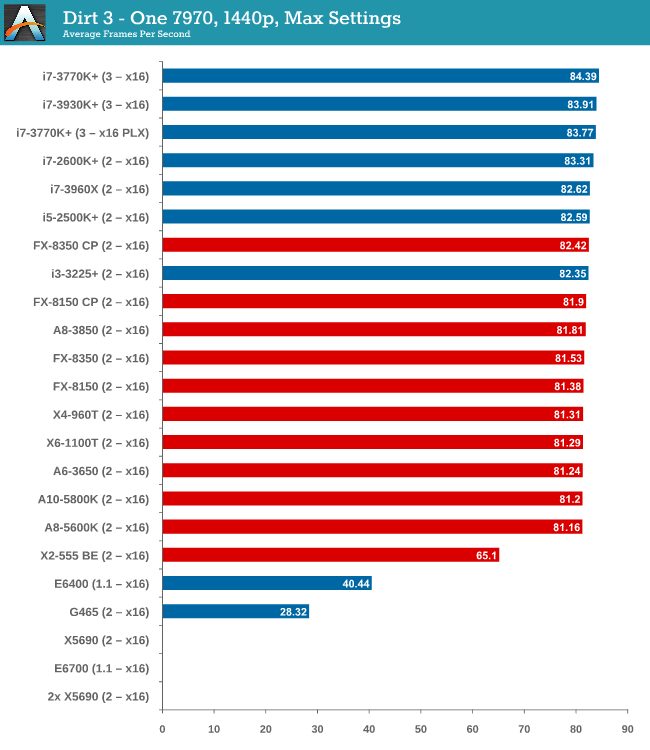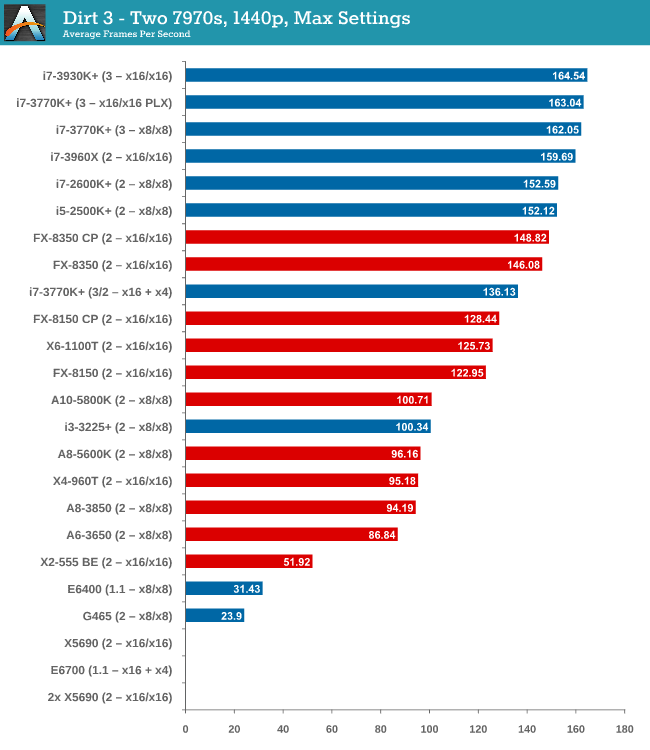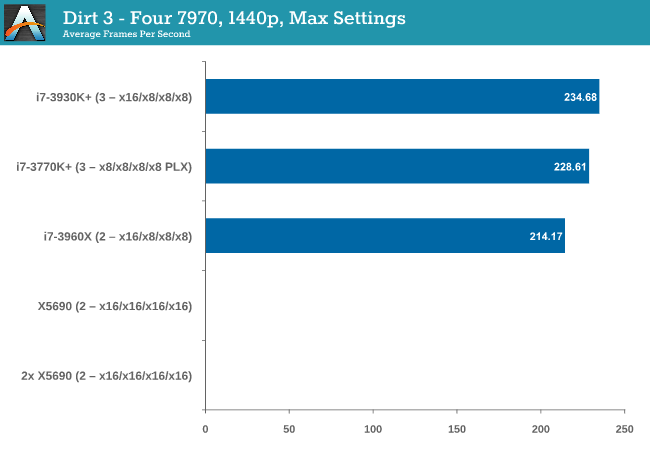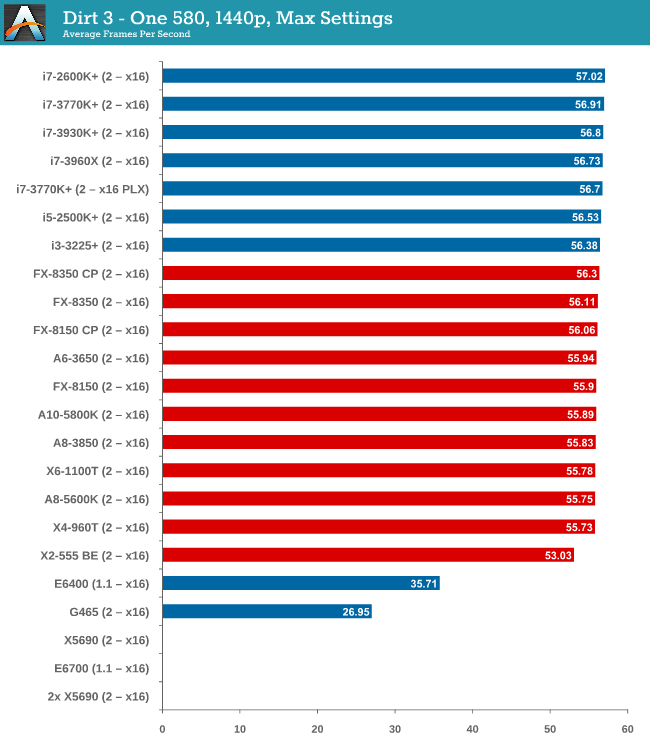Choosing a Gaming CPU: Single + Multi-GPU at 1440p, April 2013
by Ian Cutress on May 8, 2013 10:00 AM ESTDiRT 3
DiRT 3 is a rallying video game and the third in the Dirt series of the Colin McRae Rally series, developed and published by Codemasters. DiRT 3 also falls under the list of ‘games with a handy benchmark mode’. In previous testing, DiRT 3 has always seemed to love cores, memory, GPUs, PCIe lane bandwidth, everything. The small issue with DiRT 3 is that depending on the benchmark mode tested, the benchmark launcher is not indicative of game play per se, citing numbers higher than actually observed. Despite this, the benchmark mode also includes an element of uncertainty, by actually driving a race, rather than a predetermined sequence of events such as Metro 2033. This in essence should make the benchmark more variable, but we take repeated runs in order to smooth this out. Using the benchmark mode, DiRT 3 is run at 1440p with Ultra graphical settings. Results are reported as the average frame rate across four runs.
One 7970

While the testing shows a pretty dynamic split between Intel and AMD at around the 82 FPS mark, all processors are roughly +/- 1 or 2 around this mark, meaning that even an A8-5600K will feel like the i7-3770K.
Two 7970s

When reaching two GPUs, the Intel/AMD split is getting larger. The FX-8350 puts up a good fight against the i5-2500K and i7-2600K, but the top i7-3770K offers almost 20 FPS more and 40 more than either the X6-1100T or FX-8150.
Three 7970s

Moving up to three GPUs and DiRT 3 is jumping on the PCIe bandwagon, enjoying bandwidth and cores as much as possible. Despite this, the gap to the best AMD processor is growing – almost 70 FPS between the FX-8350 and the i7-3770K.
Four 7970s

At four GPUs, bandwidth wins out, and the PLX effect on the UP7 seems to cause a small dip compared to the native lane allocation on the RIVE (there could also be some influence due to 6 cores over 4).
One 580

Similar to the one 7970 setup, using one GTX 580 has a split between AMD and Intel that is quite noticeable. Despite the split, all the CPUs perform within 1.3 FPS, meaning no big difference.
Two 580s

Moving to dual GTX 580s, and while the split gets bigger, processors like the i3-3225 are starting to lag behind. The difference between the best AMD and best Intel processor is only 2 FPS though, nothing to write home about.
DiRT 3 conclusion
Much like Metro 2033, DiRT 3 has a GPU barrier and until you hit that mark, the choice of CPU makes no real difference at all. In this case, at two-way 7970s, choosing a quad core Intel processor does the business over the FX-8350 by a noticeable gap that continues to grow as more GPUs are added, (assuming you want more than 120 FPS).










242 Comments
View All Comments
Pheesh - Wednesday, May 8, 2013 - link
"2) Min FPS falls under the issue of statistical reporting. If you run a game benchmark (Dirt3) and in one scene of genuine gameplay there is a 6-car pileup, it would show the min FPS of that one scene. So if that happened on an FX-8350 and min-FPS was down to 20 FPS when others didn't have this scene were around 90 FPS for minimum, how is that easily reported and conveyed in a reasonable way to the public? A certain amount of acknowledgement is made on the fact that we're taking overall average numbers, and that users would apply brain matter with regard to an 'average minimum'."The point of a benchmark is to provide a consistent test that can be replicated exactly on multiple systems. If you're not able to do that then you aren't really benchmarking anything. That's why 99% of games are not tested in multiplayer but rather single player in experiences they can strictly control. (i.e. with test demos). If for some reason the game engine is just that unpredictable even in a strictly controlled test situation you could do multiple trials to take a minimum average.
Minimum FPS is an extremely necessary test and its easily possible to do. Other sites include it with all of their gaming benchmarks.
Spunjji - Wednesday, May 8, 2013 - link
That doesn't necessarily mean that the numbers they give you are worth a damn...beginner99 - Thursday, May 9, 2013 - link
"Minimum FPS is an extremely necessary test and its easily possible to do. Other sites include it with all of their gaming benchmarks."Or you could do 5 runs, discard the worst and best and average the rest (min, max average FPS).
http://en.wikipedia.org/wiki/Truncated_mean
But yeah statistics is extremely complex and error prone. I once read that a large amount of statistics in scientific publications have errors to a certain degree (but not necessarily making the results and conclusions completely wrong!!!)
Or if you actually know such a "special scene" can happen, discard all test were it happened.
beginner99 - Thursday, May 9, 2013 - link
The main issue here is actually available time or the amount of work. Averages over 3 aren't really that great. if you could run everything 100 times such "special scenes" would be irrelevant.mapesdhs - Monday, May 20, 2013 - link
Ian,
P55 boards can offer very good RAID0 performance with SSDs, or more importantly
RAID1 or RAID10 (I hope those with RAID0 have some kind of sensible backup
strategy). See my results:
http://www.sgidepot.co.uk/misc/ssd_tests.txt
One will obviously get more out of newer SSDs using native SATA3 mbds for the
sequential tests, but newer tech won't help 4K numbers that much. In reality few
would notice the difference between each type of setup. This is especially true
given how many later mbds use the really awful Marvell controllers for most of the
SATA3 ports (such a shame only a couple are normally controlled by the Intel or
other chipset); performance would be better with an older Intel SATA2. I expect
many just use the non-Marvell ports only if they can.
What matters is to have an SSD setup of some kind in the 1st place. My P55 system
(875K) boots very quick with a Vertex3, gives a higher 3DMark13 physics score than
a 3570K, and GPU performance with two 2x 560Ti is better than a stock 680. It's
really the previous gen of hw which can present more serious bottlenecks (S775,
AM2, DDR2, etc.), but even then results can often be surprisingly decent, eg. oc'd
Ph2 965, etc.
Also, RAID0 with SSDs often negates the potential of small I/O performance.
Depending on the game/task, this means SSD RAID0 might at times be slower than a
single good SSD.
Dribble is right in that respect, improvements are often not as significant as
people think or expect (I've read sooo many posts from those who have been
disappointed with their upgrades), though it does vary by game, settings, etc.
Games which impose a heavier CPU loading (physics, multiplayer, AI etc.) might see
more useful speedups from a better CPU, but not always. There are so many factors
involved, it can become complicated very quickly.
Ian.
Felix_Ram - Sunday, May 26, 2013 - link
Your 120 hz screen has a frame latency of about 8 ms. Meaning it effectively can't show you more than 60 new fps. Anything above that it shows you the same pixel twice. So basically, you are watching reruns, and anyone who states that he can tell a difference between 60 fps and +60fps is basically kidding himself.http://forums.anandtech.com/showthread.php?t=23049...
http://forums.steamgames.com/forums/showthread.php...
Felix_Ram - Sunday, May 26, 2013 - link
Can't edit. A screen latency of about 16 ms*tehh4ck3r - Wednesday, May 8, 2013 - link
You should test a Phenom II X4-965 and a i5-3570K.B-Unit1701 - Wednesday, May 8, 2013 - link
And throw in a 45nm Core2, preferably over 3.0Ghzboulard83 - Wednesday, May 8, 2013 - link
Really great review and testing. As for the CPU to add to the list, you could add some very cheap solution like the G1610 and G2020 too see how these 40-60$ chip perform againts all other chip or simply compare to an older E6700 like the one on the test. Other than that, you could also add a 3820 in the testing simply to lower the cost of the X79 setup, making it a little more mainstream VS a 600$ 3930k.